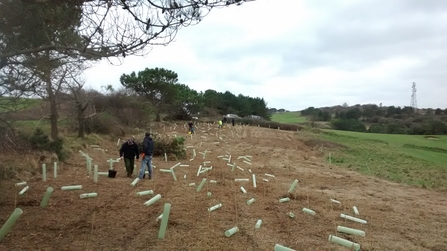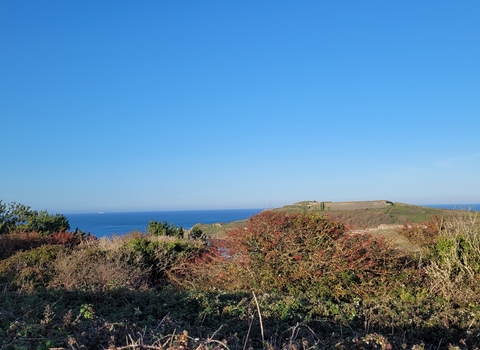The Alderney Community Woodland (ACW) was started in 2009 to try and bring native tree cover back to Alderney as well as being a focal point for the community and wildlife. Historic features, built heritage and a variety of habitats and wildlife come together in this 17 hectare site to create what we hope will be a unique and diverse landscape. With over 12,000 trees planted the ACW makes up around 2% of Alderney's total area. The Species planted are native broadleaf trees and it is hoped that the establish woodland will begin to naturally spread and regenerate.

ACW management
In 2009 the AWT, working closely with the States of Alderney, initiated the ACW project. This was done in collaboration with more than 20 stakeholders and with the support of many local groups and hundreds of volunteers. The ACW was formally established in 2011 with the publication of the ACW Development Plan for 2011-2014. The aim is to create a large and centralised woodland habitat with native broadleaved trees rich in wildlife, sustainably managed for the benefit of the local community and providing educational and recreational facilities. We hope also to keep traditional woodland skills (such as greenwood turning) alive.
The main achievements to date are:
- Between 2010 and 2013 Woodland cover on the ACW has been doubled through the planting of over 10,000 native deciduous trees and shrubs such as oak, birch, hazel, ash and blackthorn among others. There was a continual effort towards the aftercare of trees; replacing dead trees, clearing in and around tree guards, and preventing scrub encroachment particularly in the orchard.
- In 2022, in honour of the late Queen Elizabeth II's Platinum Jubilee, the AWT was able to provide every resident of Alderney with a free tree! This was in partnership with the States of Alderney and resulted in a further 2,000 trees being planted on the island - the majority of which were planted in the ACW. These were all native species and included: Rowan, English Oak, Hazel, Silver Birch and Field Maple. We hosted community tree-planting days throughout our annual Alderney Woodland Week in the autumn and worked with St. Anne's School to involve the Year 3, 4, 5 and 6 pupils. To read more about the Platinum Jubilee Woodland, click here.
- Heritage sites have, and continue to be, restored and refurbished to allow safe access, and also to provide a valuable educational resource where possible.
- The network of paths has been extended and almost doubled, with new paths being opened allowing a fuller enjoyment of the site and its unusual history and topography. Paths have been continually maintained to enable access to the woodland, historical features, and educational areas.
- The site has been opened to a wide range of events and recreational activities and is becoming an increasingly important focal point of the island, culminating in woodland week in November of each year.
- Benches have been made and firewood harvested from the felled pine trees and sold or distributed and the proceeds reinvested into the ACW.

What can I do there?
Local residents and visitors can walk around, enjoy the woodland and wildlife and visit the archaeological features and cultural heritage. At the same time, the ACW provides educational facilities for schools, clubs and associations, as well as having great amenity value for a wide range of groups. The main Woodland Bunker is also a classroom and meeting space available on request to any group.
Regular events to promote woodland culture and training sessions to sustain traditional knowledge take place in the ACW as well.
The ACW is situated on States of Alderney land, and is currently managed by the AWT in partnership with two tenants and a number of closely involved groups, societies and businesses.
What does the future hold?
The ACW Management Plans, updated every five years, aim to continue the work that began in 2009, updating the background information for the site and providing the focus and direction of management of the site for each five year period.
According to the ACW's "community approach", community involvement is the key to the ACW’s long term future and therefore the AWT has aimed to encourage local residents to get involved in all aspects of the site’s development and on-going management, through active participation as well as through consultation.
Unfortunately, in 2018 ash dieback was found on the island. As ash is the second most common native tree species, after rusty sallow, this has the potential to greatly affect the ACW and established woody areas. You can read more about ash dieback and how we are responding in our FAQs.
Over 500 people and 20 organisations have been instrumental in the founding of the ACW. We welcome any interest in the project you might have, whether to simply learn a little more or, we hope, get involved yourselves.
To read more about our current management planning activities see our Nature Reserves and Sites page.
ACW Plans

©Greg Richardson

